















|
Nothing endures but change.
- Heraclitus
Io [EYE-oh or EE-oh] can be classified as one of the most unusual moons in our solar system. Active volcanism on Io was the greatest unexpected discovery at Jupiter. It was the first time active volcanoes had been seen on another body in the solar system. The Voyagers observed the eruption of nine volcanoes on Io altogether. There is also evidence that other eruptions occurred between Voyager encounters. Plumes from the volcanoes extend to more than 300 kilometers (190 miles) above the surface, with material being ejected at speeds up to a kilometer (.6 miles) per second.
Io's volcanoes are apparently due to heating of the satellite by tidal pumping. Io is perturbed in its orbit by Europa and Ganymede, two other large satellites nearby, then pulled back again into its regular orbit by Jupiter. This tug-of-war results in tidal bulging as great as 100 meters (330 feet) on Io's surface.
The temperature on Io's surface is about -143° C (-230° F); however, a large hot spot associated with a volcanic feature measured about 17° C (60° F). Scientists believe the hot spot may be a lava lake, although the temperature indicates the surface is not molten. This feature is reminiscent of lava lakes on Earth.
Io is composed primarily of rocky material with very little iron. Io is located within an intense radiation belt of electrons and ions trapped in Jupiter's magnetic field. As the magnetosphere rotates with Jupiter, it sweeps past Io and strips away about 1,000 kilograms (1 ton) of material per second. The material forms a torus, a doughnut shaped cloud of ions that glow in the ultraviolet. The torus's heavy ions migrate outward, and their pressure inflates the Jovian magnetosphere to more than twice its expected size. Some of the more energetic sulphur and oxygen ions fall along the magnetic field into the planet's atmosphere, resulting in auroras.
Io acts as an electrical generator as it moves through Jupiter's magnetic field, developing 400,000 volts across its diameter and generating an electric current of 3 million amperes that flows along the magnetic field to the planet's ionosphere.
| Animations of Io |
|---|
| Views of Io |
|---|
See also: Galileo Images of Io.
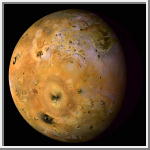 Color Image of Io
Color Image of Io
This color image of Io was created by combining the color
channels of the low resolution USGS Voyager controlled color mosaic with
Tayfun Oner's high resolution Galileo mosaic. The brown, orange areas are
probably covered by sulphur or a mixture containing sulphur. The light areas
may be sulphur dioxide snow and the pock-marks are mostly volcanic
calderas up to 200 kilometers (124
miles) across. Mountainous regions exist near both poles, with some
features rising 8 kilometers (5 miles) or more above their surroundings.
(Courtesy A.Tayfun Oner)
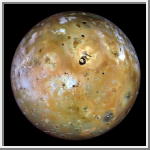 Io Feature Map
Io Feature Map
This is the highest resolution color global mosaic of Io. It was created by
combining the color channels of the low resolution USGS
controlled color mosaic with the high resolution B&W controlled USGS
mosaic. It was then projected to an ortographic projection
centered at 0 degrees latitude and 315 degrees longitude.
(Courtesy A.Tayfun Oner)
 Io Shown in Lambertian Equal Area Projection
Io Shown in Lambertian Equal Area Projection
Voyager 1 computer color mosaics, shown in
approximately natural color and in Lambertian equal-area projections, show
the Eastern (left) and Western (right) hemispheres of Io. Almost all the
features visible here have volcanic origins, including several calderas and
eruption plumes that were active at the time of the Voyager 1 encounter.
 Global Mercator Mosaic
Global Mercator Mosaic
Io's volcanic plains are shown in this Voyager 1 image
mosaic which covers the area roughly from latitude 60 degrees N. to
latitude 60 degrees S. and longitude 100-345. North is up. Numerous
volcanic calderas, lava flows, and volcanic eruption plumes are visible
here. The composition of Io's volcanic plains and lava flows has not been
determined, but they could consist dominantly of sulfur with surface
frosts of sulfur dioxide or of silicates (such as basalt) encrusted with
sulfur and sulfur dioxide condensates. The bright whitish patches probably
consist of freshly deposited sulfur dioxide frost.
 Mercator Mosaic Using Galileo C3 Images
Mercator Mosaic Using Galileo C3 Images
This image is a mosaic of Io based of Galileo C3 Io images. The USGS
controlled global mosaic was used for reference. This map is a mercator
projection with the central longitude at 180° and the latitude covers
-70° to 70°.
(Courtesy A.Tayfun Oner)
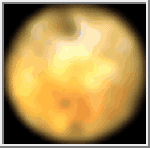 Hubble Resolves Volcanoes on Io
Hubble Resolves Volcanoes on Io
This image of Jupiter and its satellite Io were taken on March 5, 1994.
Io is too small for ground-based telescopes to see the surface details.
Several of the volcanoes periodically are active because Io is heated
by tides raised by Jupiter's powerful gravity. The volcano Pele
appears as a dark spot surrounded by an irregular orange oval in the
lower part of the image. The orange material has been ejected from
the volcano and spread over a huge area. Though the volcano was first
discovered by Voyager, the distinctive orange color of the volcanic
deposits is a new discovery in these Hubble Space Telescope images.
(Voyager missed it because its cameras were not sensitive to the
near-infrared wavelengths where the color is apparent).
(Credit: John Spencer, Lowell Observatory; NASA)
 Hubble Discovers Bright New Spot on Io
Hubble Discovers Bright New Spot on Io
This pair of Hubble images of Jupiter's volcanic
moon Io shows the surprising emergence of a 320-kilometer (200-mile)
diameter, large yellowish-white feature near the center of the moon's
disk (photo on the right). Scientists suggest the spot may be a new
class of transient feature on the moon. For comparison, the
photo on the left was taken in March 1994 before the spot emerged,
and shows that Io's surface had undergone only subtle changes since it
was last seen by the Voyager 2 probe in 1979.
The new spot in the July 1995 Hubble image replaces a smaller whitish
spot seen at about the same location in the March 1994 image. "The new
spot surrounds the volcano Ra Patera, which was photographed by Voyager,
and is probably composed of material, probably frozen gas, ejected from
Ra Patera by a large volcanic explosion or fresh lava flows,"
according to John Spencer of Lowell Observatory in Flagstaff, Arizona.
(Credit: J. Spencer, Lowell Observatory/NASA)
 Volcanic Plumes
Volcanic Plumes
Voyager 2 took this picture of Io
on the evening of July 9, 1979, from a range of 1.2 million kilometers
(745,700 miles). On the limb of Io are two blue volcanic eruption
plumes about 100 kilometers (62 miles) high. These two plumes were first
seen by Voyager 1 in March 1979 and are designated Plume 5 (upper) and
Plume 6 (lower). They apparently had been erupting for a period of at
least four months and probably longer. A total of six plumes were seen
by Voyager 2, all of which were first seen by Voyager 1. Plume 1, the
largest volcano viewed by Voyager 1, was no longer erupting when Voyager
2 arrived. Plume 4 was not viewed on the edge of Io's disc by Voyager 2
and, therefore, it is not known whether it was still erupting.
(Courtesy NASA/JPL)
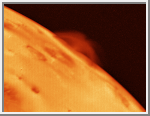 Loki Volcano
Loki Volcano
Voyager 1 took this picture of the Loki volcano on March 4, 1979. The
volcanic eruption can be seen on the limb of Io.
(Credit: Calvin J. Hamilton)
 Loki Patera
Loki Patera
This is a close up view of Io's northern hemisphere.
The central feature has been named Loki Patera. The large dark
area might be a lake of liquid sulphur with a raft of solid sulphur
inside.
(Credit: Calvin J. Hamilton)
 Venting Gasses
Venting Gasses
This photograph of Io shows what
appears to be a volcanic caldera that is venting gasses (the bright blue
patch at left center). In the photo is a network of volcanic calderas with
dark floors linked by bright red materials. The northernmost caldera has a
bright blue patch on the floor. Scientists believe the bright blue patch
may be clouds of gas issuing from volcanic vents. The gas clouds may
condense to form extremely fine particles that appear blue. Since
Voyager 1's
infrared spectrometer has discovered sulfur dioxide on Io, it is
possible that sulfur dioxide is the main component of the clouds. Sulfur
dioxide clouds would rapidly freeze and snow back to the surface. It is
also possible that dark areas in the floors of the calderas are pools of
molten sulfur, a very dark form of sulfur. The image was taken March 5,
1979, as Voyager 1 approached Io, and was taken from
129,600 kilometers (80,500 miles).
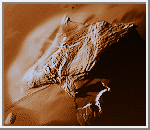 Haemus Mons
Haemus Mons
Haemus Mons is a mountain located near the south pole and in this image
near the terminator of Io. Its base
measures about 200 by 100 kilometers (124 by 62 miles). Several mountain
peaks are found on Io some measuring as high as 10 kilometers (6.2 miles)
tall.
(Credit: Calvin J. Hamilton)
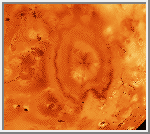 Volcano Pele
Volcano Pele
The heart shaped feature in the center of this image was caused by
volcanic ejecta thrown out of the
eruptive Pele.
(Credit: Calvin J. Hamilton)
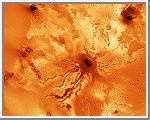 Ra Patera
Ra Patera
Ra Patera is a large shield volcano with multi colored flows. This image
shows at least a dozen dark flows originating from the central dark vent.
Some of these flows are 300 kilometers (186 miles) in length.
(Credit: Calvin J. Hamilton)
Copyright © 1997 by Calvin J. Hamilton. All rights reserved.